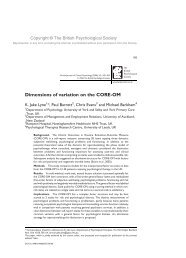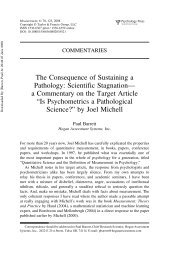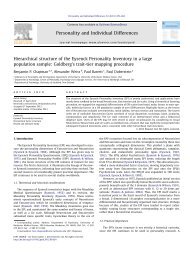Psychophysiological Methods - Paul Barrett
Psychophysiological Methods - Paul Barrett
Psychophysiological Methods - Paul Barrett
- No tags were found...
You also want an ePaper? Increase the reach of your titles
YUMPU automatically turns print PDFs into web optimized ePapers that Google loves.
Breakwell-3389-Ch-08.qxd 2/7/2006 8:49 PM Page 156Box 8.1(Continued)coil. Because increased neural processing requires increased oxygen consumption,and because the magnetic resonance signal from deoxygenated blood is reducedrelative to oxygenated blood, changes in the blood oxygen level dependent (BOLD)response are related to changes in underlying neural activity in a given brain area.Statistical analysis of fMRI BOLD data attempts to relate changes in stimulationapplied by the experimenter to changes in the BOLD response in different brainareas. From this type of analysis various types of deduction can be made includingthose about the functional role of different brain areas, about the interactionsbetween brain areas, about the mechanisms of learning in the brain and about themodulation of brain activity by factors such as task.In recent years there has been an explosion of fMRI-based research. To takeone example, by using fMRI, researchers have been able to identify brain areasthat seem to be associated with psychological cravings (Myrick et al., 2004).8.3 QUANTIFYING BIOSIGNAL DATA8.3.1 Level of measurementAs can be seen from the information presented in Section 8.2, the measurementsmade from psychophysiological data are almost always at true ratio level – thatis, they behave like interval level measurements and possess a true zero (seeChapter 3). However, despite the high level of precision of psychophysiologicalmeasurements, the psychologist using these measures faces a significant problem.She must determine the psychological meaningfulness of any change in thebiosignal. For instance, returning to the earlier example of using heart rate variabilityas a measure of mental workload, a statistically significant change in heartrate variability may not necessarily signify a psychologically meaningful changein mental workload. Thus, the interpretation of psychophysiological data is oftenmore qualitative than the precision of the measures might seem to imply.8.3.2 Hardware, signal processing and data volumeHaving established that the scale of measurement is superior to that of nearly allpsychological data, it is apparent that many issues in the quantification of parametersthat bedevil psychology fade into insignificance in this area. However, theprice of this philosophical simplicity is computational and methodological complexity.The measures made are invariably electrically based, exact to a predeterminedlevel of accuracy defined by the properties of the sensors and any amplificationused, and prone to levels of noise that can utterly distort any parameter or signal.So, in order to attempt to measure any physiological parameter from any part ofthe human body, fairly detailed knowledge is required of the underlying physiologyto be assessed, the physical properties of the sensors or transducers to be156 RESEARCH METHODS IN PSYCHOLOGY












